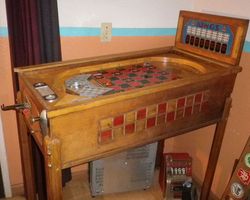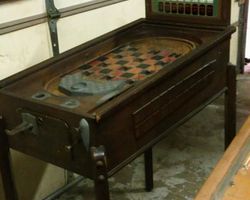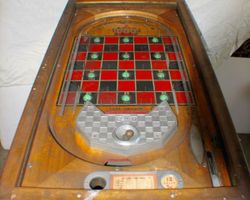Kings

Produced: April, 1935
Machine Type: Electro-mechanical
Players: 1
The Genco Manufacturing Company introduced "Kings" in April of 1935, at a pivotal moment in the burgeoning pinball industry. This electro-mechanical (EM) machine emerged during a period when pinball was rapidly evolving from simple bagatelle-style games into more complex and interactive forms of amusement. Genco, a prominent manufacturer of coin-operated games during the first half of the 20th century, sought to capture the public's attention with machines that offered both novelty and perceived value. "Kings" embodied this philosophy, providing extended gameplay for a modest cost.
The design and production of "Kings" were rooted in the engineering principles of early EM games. These machines relied on a network of relays, solenoids, and mechanical components to control lighting, scoring, and ball delivery, predating the digital circuits that would define later eras. While specific designers or artists for "Kings" are not widely documented, the machine's aesthetics reflect the prevailing Art Deco influences of the 1930s. Its production run contributed to Genco's market presence, establishing it as a purveyor of engaging parlor games. An intriguing aspect of "Kings" production is the existence of machines with two distinct backglass colors – a blue version and a rarer green variant – a manufacturing curiosity whose purpose remains a subject of speculation among collectors.
Signature Features and Design
"Kings" distinguishes itself with several defining characteristics that were innovative for its time. Foremost among these is its generous offering of twelve balls for a single five-cent play. This high ball count provided players with a lengthy experience, encouraging repeat plays and offering ample opportunities to master the game's objectives. In an era when value for money was paramount, this feature significantly enhanced player appeal.
Central to the machine's visual and mechanical identity is its "checkerboard artwork" on the playfield, which is directly tied to the primary gameplay objective. The playfield layout features a series of holes arranged in a grid-like fashion, creating the visual impression of a checkerboard. These holes serve as the primary targets for ball capture. The game's core concept revolved around landing balls into these specific playfield holes to complete one of eight pre-defined patterns. Each completed pattern would illuminate a corresponding "King" on the backglass, signifying progression and achievement. This interplay between the playfield's visual design and the backglass feedback created a clear, immediate understanding of the game's state, a sophisticated design for the period. The absence of flippers, common for games of this vintage, placed a heightened emphasis on the initial plunger shot and subsequent nudging skills.
Playfield and Mechanics
The playfield of "Kings" presents a layout focused entirely on precision and controlled ball trajectory, a stark contrast to the dynamic, kinetic layouts of post-flipper machines. The "checkerboard" of holes dominates the play area, forming the targets players aim for. These holes are not merely scoring opportunities; they are the literal building blocks for achieving the game's main objectives. The design philosophy was one of calculated shots and strategic decision-making within the constraints of a non-flipper game. Players relied on the strength and angle of their initial plunger shot, along with subtle nudges and bumps of the cabinet, to guide the ball towards desired hole patterns.
The flow of "Kings" is methodical rather than rapid. Each ball presents a fresh opportunity to contribute to a pattern. The artwork, characterized by its grid lines and numerical or symbolic designations for each hole, serves a dual purpose: aesthetic appeal and clear instruction. Lighting on the playfield, while rudimentary by modern standards, would have highlighted the active target areas or indicate successful ball capture within a pattern. The backglass, adorned with the eight target patterns and the series of "King" lights, served as the central informational display. As patterns were completed, the illuminated Kings provided a tangible sense of accomplishment, immersing the player in the game's progression through visual cues rather than complex animations or sound effects.
Gameplay Dynamics
The gameplay dynamics of "Kings" are rooted in its pattern-matching mechanic. The primary objective is to strategically land balls into specific playfield holes to complete any of the eight distinct patterns illustrated on the backglass. Players must analyze the patterns and attempt to fill the required holes, a challenge that combines luck with rudimentary skill in ball control. Each successful completion of a pattern triggers the illumination of a corresponding "King" on the backglass, providing clear visual feedback on progress. The game's progression is measured by the number of Kings lit, encouraging players to attempt to complete as many unique patterns as possible within their allotted balls.
"Kings" offered two distinct play modes, selectable by the operator, which significantly altered the game's challenge and pace. "Regular Play" provided a generous twelve balls, allowing for extended gameplay and multiple attempts at pattern completion. This mode suited players seeking a more relaxed experience or those looking to maximize their chances of lighting multiple Kings. In contrast, "Fast Play" reduced the ball count to six, dramatically increasing the difficulty and requiring a more precise and efficient approach to pattern completion. This mode challenged players to make every shot count, turning the game into a test of focused accuracy under pressure. Player strategies involved not just aiming for individual holes but mentally tracking which patterns were closest to completion and prioritizing shots to maximize the number of lit Kings. The game's appeal came from its straightforward objective combined with the variability introduced by the two play modes and the player's ability to influence the outcome through nudging.
Reception and Legacy
"Kings" occupied a notable position in the early electro-mechanical pinball landscape, primarily due to its distinct gameplay proposition. Its strength lay in the generous twelve-ball play, which offered a compelling value proposition and extended engagement for the player, a significant draw in the 1930s amusement market. The pattern-matching objective, clearly displayed on the backglass, provided a unique and accessible goal beyond mere point accumulation, allowing players to focus on strategic completion rather than abstract scores. The dual play modes (Regular and Fast Play) offered operators flexibility and catered to different player preferences for challenge and duration.
However, the machine's design, typical of its era, also presented inherent limitations when viewed through the lens of future pinball innovations. The absence of flippers meant gameplay was heavily reliant on the initial plunger shot and the player's ability to subtly manipulate the machine through nudging, which could be seen as less interactive compared to later designs. The repetitive nature of aiming for static holes, while challenging, lacked the dynamic flow and diverse shot opportunities that would become hallmarks of flipper-equipped games. Despite these characteristics, "Kings" holds a place in pinball history as an example of innovative game design for its period. It demonstrated the appeal of progressive objectives and backglass feedback, concepts that would evolve and find their way into more complex pinball machines. Its existence with variant backglass colors also adds to its historical intrigue, making it a point of interest for those studying the evolution of pinball manufacturing and design aesthetics. "Kings" stands as a testament to the creative problem-solving within early pinball, offering extended play and a clear, engaging objective within the technological constraints of 1935.
Sponsored Links
 Ebay Listings
Ebay Listings
 Auction Results
Auction Results
| Cost | Location | Date |
|---|---|---|
| USD $300 |  Maryland, United States Maryland, United States |
26 June, 2025 |
| USD $1,500 |  New York, United States New York, United States |
05 September, 2018 |
| USD $350 |  Illinois, United States Illinois, United States |
22 September, 2015 |
| USD $395 |  Minnesota, United States Minnesota, United States |
25 August, 2015 |
| USD $450 |  California, United States California, United States |
19 November, 2014 |


Private Policy · Search Website · Contact Us
As an eBay Partner, we may earn a commission from qualifying purchases made through links on this site, at no additional cost to you.
All trademarks and copyrighted materials remain property of their respective owners. All other content copyright 2007 - 2025 Pinpedia.




